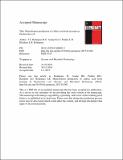| dc.contributor.author | Rodrigues, J. L. | |
| dc.contributor.author | Araujo, R. G. | |
| dc.contributor.author | Prather, Kristala L. Jones | |
| dc.contributor.author | Kluskens, L. D. | |
| dc.contributor.author | Rodrigues, L. R. | |
| dc.date.accessioned | 2016-04-28T13:52:25Z | |
| dc.date.available | 2016-04-28T13:52:25Z | |
| dc.date.issued | 2015-01 | |
| dc.date.submitted | 2014-12 | |
| dc.identifier.issn | 01410229 | |
| dc.identifier.uri | http://hdl.handle.net/1721.1/102314 | |
| dc.description.abstract | Caffeic acid is a plant secondary metabolite and its biological synthesis has attracted increased attention due to its beneficial effects on human health. In this study, Escherichia coli was engineered for the production of caffeic acid using tyrosine as the initial precursor of the pathway. The pathway design included tyrosine ammonia lyase (TAL) from Rhodotorula glutinis to convert tyrosine to p-coumaric acid and 4-coumarate 3-hydroxylase (C3H) from Saccharothrix espanaensis or cytochrome P450 CYP199A2 from Rhodopseudomonas palustris to convert p-coumaric acid to caffeic acid. The genes were codon-optimized and different combinations of plasmids were used to improve the titer of caffeic acid. TAL was able to efficiently convert 3 mM of tyrosine to p-coumaric acid with the highest production obtained being 2.62 mM (472 mg/L). CYP199A2 exhibited higher catalytic activity towards p-coumaric acid than C3H. The highest caffeic acid production obtained using TAL and CYP199A2 and TAL and C3H was 1.56 mM (280 mg/L) and 1 mM (180 mg/L), respectively. This is the first study that shows caffeic acid production using CYP199A2 and tyrosine as the initial precursor. This study suggests the possibility of further producing more complex plant secondary metabolites like flavonoids and curcuminoids. | en_US |
| dc.description.sponsorship | Fonds Europeen de Developpement Economique et Regional. COMPETE Program | en_US |
| dc.description.sponsorship | Fonds Europeen de Developpement Economique et Regional. ON2 Program | en_US |
| dc.description.sponsorship | Fundacao para a Ciencia e a Tecnologia (Project FCOMP-01-0124-FEDER-027462) | en_US |
| dc.description.sponsorship | Fundacao para a Ciencia e a Tecnologia (PEst-OE/EQB/LA0023/2013) | en_US |
| dc.description.sponsorship | Fundacao para a Ciencia e a Tecnologia (NORTE-07-0124-FEDER-000028) | en_US |
| dc.description.sponsorship | Fundacao para a Ciencia e a Tecnologia (NORTE-07-0124-FEDER-000027) | en_US |
| dc.description.sponsorship | Fundacao para a Ciencia e a Tecnologia (Grant SFRH/BD/51187/2010) | en_US |
| dc.description.sponsorship | Fundacao para a Ciencia e a Tecnologia (SYNBIOBACTHER Project PTDC/EBB-BIO/102863/2008) | en_US |
| dc.language.iso | en_US | |
| dc.publisher | Elsevier | en_US |
| dc.relation.isversionof | http://dx.doi.org/10.1016/j.enzmictec.2015.01.001 | en_US |
| dc.rights | Creative Commons Attribution-NonCommercial-NoDerivs License | en_US |
| dc.rights.uri | http://creativecommons.org/licenses/by-nc-nd/4.0/ | en_US |
| dc.source | Prof. Prather via Erja Kajosalo | en_US |
| dc.title | Heterologous production of caffeic acid from tyrosine in Escherichia coli | en_US |
| dc.type | Article | en_US |
| dc.identifier.citation | Rodrigues, J.L., R.G. Araujo, K.L.J. Prather, L.D. Kluskens, and L.R. Rodrigues. “Heterologous Production of Caffeic Acid from Tyrosine in Escherichia Coli.” Enzyme and Microbial Technology 71 (April 2015): 36–44. | en_US |
| dc.contributor.department | MIT Synthetic Biology Engineering Research Center | en_US |
| dc.contributor.department | Massachusetts Institute of Technology. Department of Chemical Engineering | en_US |
| dc.contributor.approver | Prather, Kristala L. Jones | en_US |
| dc.contributor.mitauthor | Prather, Kristala L. Jones | en_US |
| dc.relation.journal | Enzyme and Microbial Technology | en_US |
| dc.eprint.version | Author's final manuscript | en_US |
| dc.type.uri | http://purl.org/eprint/type/JournalArticle | en_US |
| eprint.status | http://purl.org/eprint/status/PeerReviewed | en_US |
| dspace.orderedauthors | Rodrigues, J.L.; Araujo, R.G.; Prather, K.L.J.; Kluskens, L.D.; Rodrigues, L.R. | en_US |
| dc.identifier.orcid | https://orcid.org/0000-0003-0437-3157 | |
| mit.license | PUBLISHER_CC | en_US |
| mit.metadata.status | Complete | |
